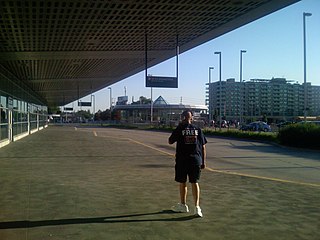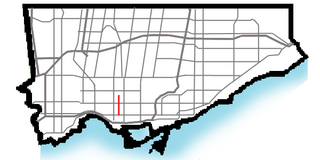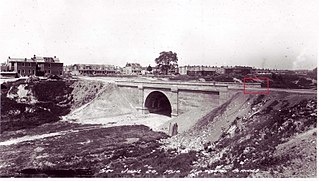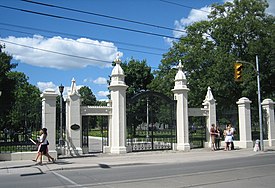
High Park is a municipal park in Toronto, Ontario, Canada. High Park is a mixed recreational and natural park, with sporting facilities, cultural facilities, educational facilities, gardens, playgrounds and a zoo. One-third of the park remains in a natural state, with a rare oak savannah ecology. High Park was opened to the public in 1876 and is based on a bequest of land from John George Howard to the City of Toronto. It spans 161 hectares and is one of the largest parks in Toronto.

Queen Street is a major east–west thoroughfare in Toronto, Ontario, Canada. It extends from Roncesvalles Avenue and King Street in the west to Victoria Park Avenue in the east. Queen Street was the cartographic baseline for the original east–west avenues of Toronto's and York County's grid pattern of major roads. The western section of Queen is a centre for Canadian broadcasting, music, fashion, performance, and the visual arts. Over the past twenty-five years, Queen West has become an international arts centre and a tourist attraction in Toronto.

Francis Gore, was an English military officer and British colonial administrator in Bermuda and Upper Canada.

Trinity—Spadina was a federal electoral district in Ontario, Canada, that was represented in the House of Commons of Canada from 1988 to 2015.

Bathurst Manor is a neighbourhood of Toronto, Ontario, Canada, located in northern Toronto in the former suburb of North York. It sits on a plateau bounded on the north by Finch Avenue West, on the west by Dufferin Street, on the east by the Don River, and on the south by Sheppard Avenue West. The area is also regarded as part of the Downsview postal area as designated by Canada Post. It is part of the former city of North York, which merged with five other municipalities and a regional government to form the new "City of Toronto" in 1998. It is part of the federal and provincial electoral district York Centre, and Toronto electoral ward 10: York Centre (East). In 2006, it had a population of 14,615.

Garrison Creek was a short stream about 7.7 kilometres (4.8 mi) long that flowed southeast into the west side of Toronto Harbour in Ontario, Canada. It has been largely covered over and filled in, but geographical traces of the creek can still be found, including the natural amphitheatre known as Christie Pits and the off-leash dog "bowl" of Trinity Bellwoods Park. The name "Garrison Creek" was used because Fort York was built near the creek mouth. Volunteers lead popular tours of the course of the old watershed.

College Street is a principal arterial thoroughfare in downtown Toronto, Canada, connecting former streetcar suburbs in the west with the city centre. The street is home to an ethnically diverse population in the western residential reaches, and institutions like the Ontario Legislature and the University of Toronto in the downtown core. At Yonge Street, College continues to the east as Carlton Street.

Toronto Parks, Forestry & Recreation (PFR) is the division of Toronto's municipal government responsible for maintaining the municipal park system and natural spaces, regulation of and provision of urban forestry services, and the delivery of recreational programming in city-operated facilities.

Dufferin Grove Park is a park in the Dufferin Grove neighbourhood of Toronto, Ontario, Canada. The park is located on the east side of Dufferin Street, south of Bloor Street West. It is located a block south of the Dufferin subway station and across the street from Dufferin Mall. The park extends two city blocks east and is primarily green-space with mixed open space and treed areas.

Alexandra Park is a neighbourhood located in downtown Toronto, Ontario, Canada. Alexandra Park is bounded by Dundas Street West on the north, Spadina Avenue on the east, Queen Street West on the south, and Bathurst Street on the west. Alexandra Park consists of private and public housing, with at grade retail along Queen Street West and Spadina Avenue, some institutional, and several commercial buildings scattered through the neighborhood. The neighborhood takes its name from Alexandra Park, a municipal park at the south-east corner of Dundas Street West and Bathurst Street. The park is named for Queen Alexandra, whose husband, King Edward VII, was the first future monarch to visit Toronto.

Ossington Avenue is a main or arterial street in Toronto, Ontario, Canada, west of downtown. While the northern 3 kilometres (1.9 mi) of Ossington Avenue is residential, its southern terminus is popularly known as the Ossington Strip, an area popular for its dining, nightlife and shopping establishments.

Crawford Street Bridge is one of two known bridges that once spanned over Garrison Creek valley — the actual creek disappeared as brick sewer by the 1920s) in Toronto, Ontario, Canada, and buried intact in the 20th century. The bridge shares design features with the larger Prince Edward Viaduct.

The Harbord Street Bridge is one of two known bridges that once spanned Harbord Street over Garrison Creek in Toronto and was partially buried intact in the 20th Century.

Trinity-Bellwoods is an inner city neighbourhood in Toronto, Ontario, Canada. It is bounded on the east by Bathurst Street, on the north by College Street, on the south by Queen Street West, and by Dovercourt Road on the west. It has a large Portuguese and Brazilian community, and many local Portuguese-Canadian businesses are located along Dundas Street West, continuing west into Little Portugal; this stretch further west along Dundas is known as Rua Açores.

Yellow Creek is a partially-buried southeasterly tributary of the Don River in Toronto. It has also been known at different times as Silver Creek, Sylvan Creek, and Rosedale Brook. The former source of Yellow Creek begins near Sheppard West station in the Downsview neighbourhood. Most of the creek and its sources are buried underground in storm sewers until they emerge into Avoca Ravine in the Deer Park neighbourhood and continue their way to the Don River.

David A. Balfour Park is an urban park in the Deer Park neighbourhood of Toronto near the intersection of Yonge Street and St. Clair Avenue. The park made up of 20.5 hectares of green space consisting of the greenery-covered Rosehill Reservoir and the entirety of the Vale of Avoca with its system of trails.

Dundas Street is a major historic arterial road in Ontario, Canada. The road connects the city of Toronto with its western suburbs and several cities in southwestern Ontario. Three provincial highways—2, 5, and 99—followed long sections of its course, although these highway segments have since been downloaded to the municipalities they passed through. Originally intended as a military route to connect the shipping port of York to the envisioned future capital of London, Ontario, the street today connects Toronto landmarks such as Yonge–Dundas Square and the city's principal Chinatown to rural villages and the regional centres of Hamilton and London.
The COVID-19 pandemic made homelessness in Toronto more visible, due to the rise of encampments in public parks. However, homelessness in Canada had been an issue of widespread concern long before the pandemic's arrival. A 2016 report found that at least 235,000 Canadians experience homelessness in a year, and 35,000 Canadians experience it on a given night. A Nanos survey found in 2020 that 72% of Canadians believed it was urgent to work toward ending homelessness in Canada. A 2020 report from the Wellesley Institute argues that there were disproportionately higher rates of evictions in Black neighborhoods, and that Black residents were among the worst hit by COVID-19. As part of its stay at home order in March 2020, the Ontario government instated a ban on evictions, however this was lifted with the emergency order in June 2020. The Ontario government however made evictions easier, according to some critics, due to its passage of Bill 184 which allowed landlords to bypass the Landlord and Tenant Board. One advocacy group deemed the cascading effects of Bill 184 'a bloodbath of evictions'. By December 2020, Toronto tenants were calling for a reinstatement of the moratorium on evictions. The crisis conditions of the pandemic lead to an increase in organizing against what many homelessness advocates deemed to be social murder of the city's unhoused. This ranged from legal lawsuits against the city's shelter system to calls for a city plan that would address the large numbers of unhoused people camping outside, to suits against encampment evictions, to large scale protests against the clearings of public parks. The Covid-19 encampments are best understood as emerging out of a longer history of urban informality in Toronto.























